In-depth Market Analysis of Reliance Retail - BUMKT1501 Marketing
VerifiedAdded on 2023/03/23
|14
|5396
|64
Report
AI Summary
This report provides a comprehensive market analysis of Reliance Retail Limited, employing theoretical marketing frameworks. It begins by introducing the core concepts of marketing and their impact on consumers and entrepreneurs. Following this, the report offers an overview of Reliance Retail and its industry background, highlighting the competitive landscape and the evolution of the Indian retail sector. The analysis extends to the business environment, examining both micro and macro factors, including the roles of the company, its customers, and competitors, as well as political, economic, social, and technological influences. An STP (Segmentation, Targeting, and Positioning) analysis is conducted to understand Reliance Retail's market approach. Building on this foundation, the report develops a marketing mix based on the 4Ps framework, specifically analyzing a new product line: Mastered oil. Academic references are integrated throughout the report to support and validate the findings, providing a robust and theoretically grounded assessment of Reliance Retail's market position and strategies.
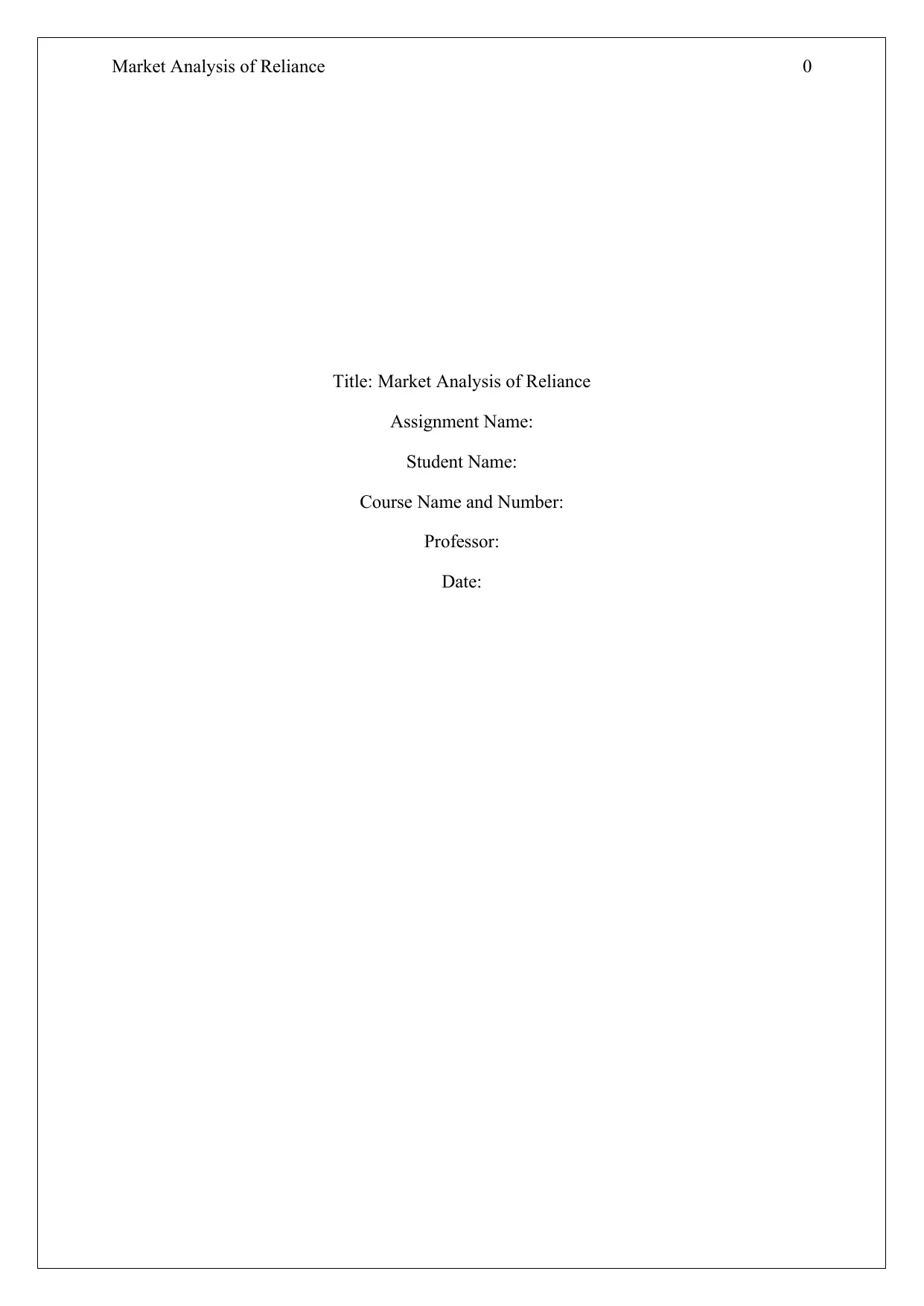
Market Analysis of Reliance 0
Title: Market Analysis of Reliance
Assignment Name:
Student Name:
Course Name and Number:
Professor:
Date:
Title: Market Analysis of Reliance
Assignment Name:
Student Name:
Course Name and Number:
Professor:
Date:
Paraphrase This Document
Need a fresh take? Get an instant paraphrase of this document with our AI Paraphraser
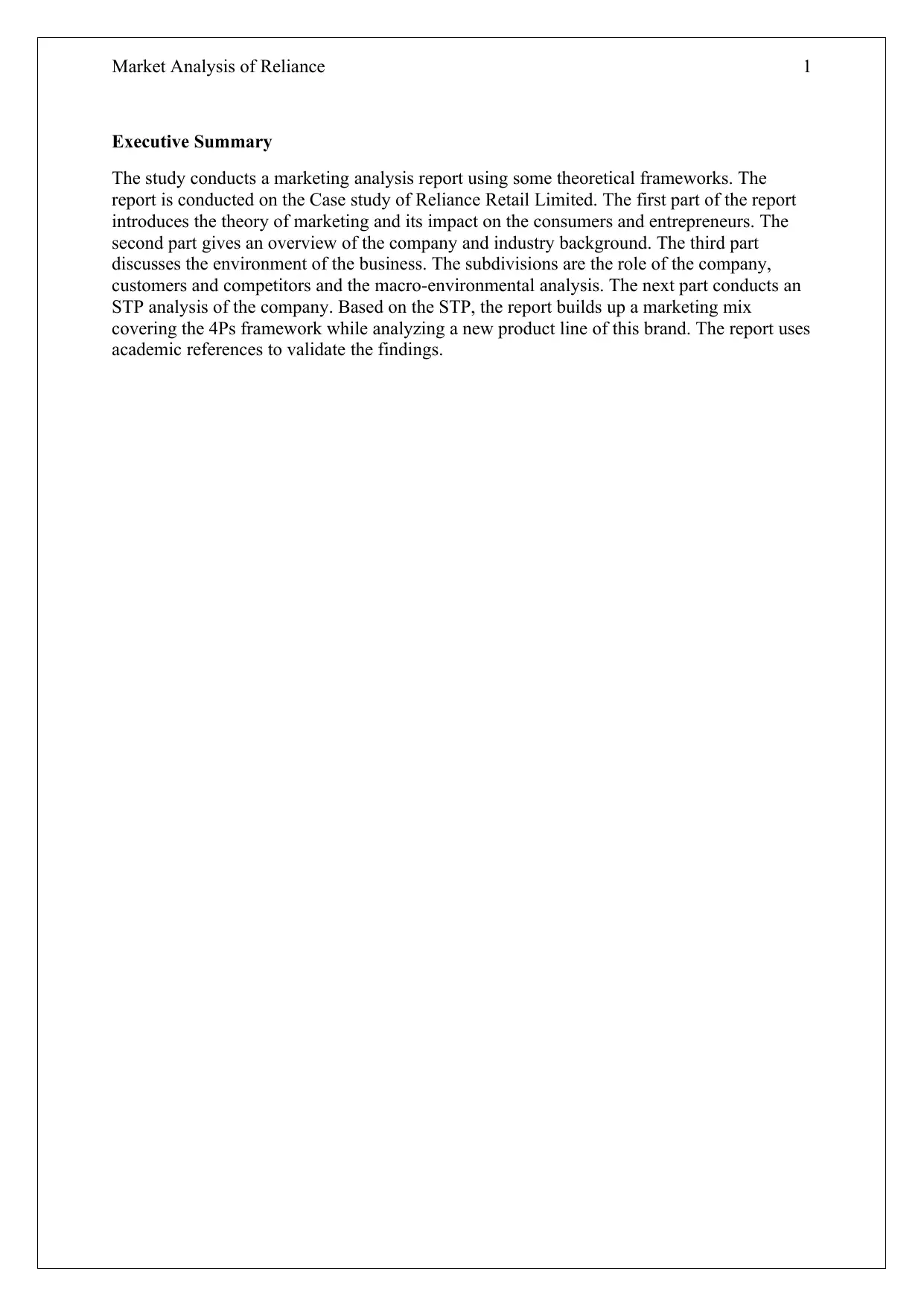
Market Analysis of Reliance 1
Executive Summary
The study conducts a marketing analysis report using some theoretical frameworks. The
report is conducted on the Case study of Reliance Retail Limited. The first part of the report
introduces the theory of marketing and its impact on the consumers and entrepreneurs. The
second part gives an overview of the company and industry background. The third part
discusses the environment of the business. The subdivisions are the role of the company,
customers and competitors and the macro-environmental analysis. The next part conducts an
STP analysis of the company. Based on the STP, the report builds up a marketing mix
covering the 4Ps framework while analyzing a new product line of this brand. The report uses
academic references to validate the findings.
Executive Summary
The study conducts a marketing analysis report using some theoretical frameworks. The
report is conducted on the Case study of Reliance Retail Limited. The first part of the report
introduces the theory of marketing and its impact on the consumers and entrepreneurs. The
second part gives an overview of the company and industry background. The third part
discusses the environment of the business. The subdivisions are the role of the company,
customers and competitors and the macro-environmental analysis. The next part conducts an
STP analysis of the company. Based on the STP, the report builds up a marketing mix
covering the 4Ps framework while analyzing a new product line of this brand. The report uses
academic references to validate the findings.
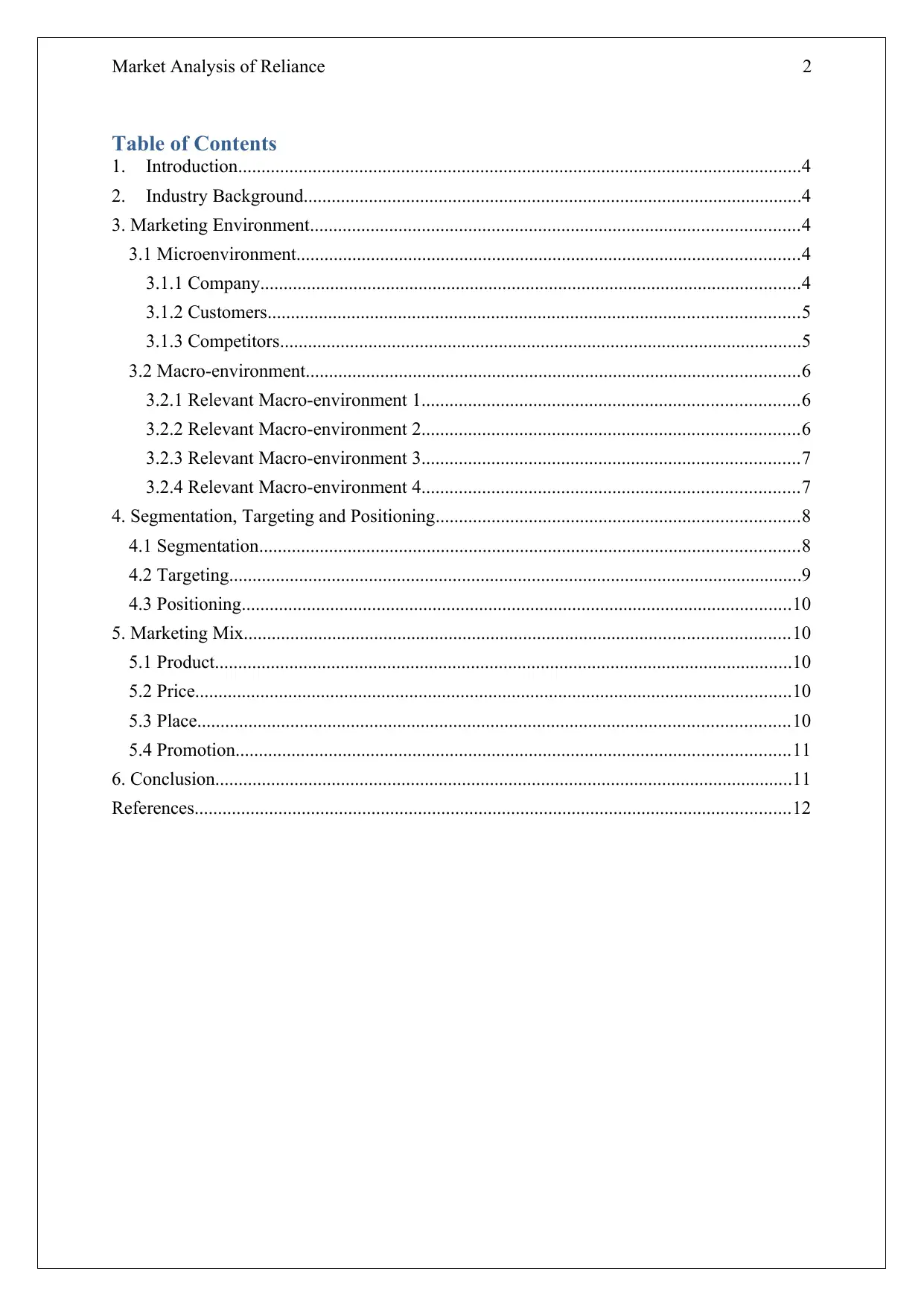
Market Analysis of Reliance 2
Table of Contents
1. Introduction.........................................................................................................................4
2. Industry Background...........................................................................................................4
3. Marketing Environment.........................................................................................................4
3.1 Microenvironment............................................................................................................4
3.1.1 Company....................................................................................................................4
3.1.2 Customers..................................................................................................................5
3.1.3 Competitors................................................................................................................5
3.2 Macro-environment..........................................................................................................6
3.2.1 Relevant Macro-environment 1.................................................................................6
3.2.2 Relevant Macro-environment 2.................................................................................6
3.2.3 Relevant Macro-environment 3.................................................................................7
3.2.4 Relevant Macro-environment 4.................................................................................7
4. Segmentation, Targeting and Positioning..............................................................................8
4.1 Segmentation....................................................................................................................8
4.2 Targeting...........................................................................................................................9
4.3 Positioning......................................................................................................................10
5. Marketing Mix.....................................................................................................................10
5.1 Product............................................................................................................................10
5.2 Price................................................................................................................................10
5.3 Place...............................................................................................................................10
5.4 Promotion.......................................................................................................................11
6. Conclusion............................................................................................................................11
References................................................................................................................................12
Table of Contents
1. Introduction.........................................................................................................................4
2. Industry Background...........................................................................................................4
3. Marketing Environment.........................................................................................................4
3.1 Microenvironment............................................................................................................4
3.1.1 Company....................................................................................................................4
3.1.2 Customers..................................................................................................................5
3.1.3 Competitors................................................................................................................5
3.2 Macro-environment..........................................................................................................6
3.2.1 Relevant Macro-environment 1.................................................................................6
3.2.2 Relevant Macro-environment 2.................................................................................6
3.2.3 Relevant Macro-environment 3.................................................................................7
3.2.4 Relevant Macro-environment 4.................................................................................7
4. Segmentation, Targeting and Positioning..............................................................................8
4.1 Segmentation....................................................................................................................8
4.2 Targeting...........................................................................................................................9
4.3 Positioning......................................................................................................................10
5. Marketing Mix.....................................................................................................................10
5.1 Product............................................................................................................................10
5.2 Price................................................................................................................................10
5.3 Place...............................................................................................................................10
5.4 Promotion.......................................................................................................................11
6. Conclusion............................................................................................................................11
References................................................................................................................................12
⊘ This is a preview!⊘
Do you want full access?
Subscribe today to unlock all pages.

Trusted by 1+ million students worldwide
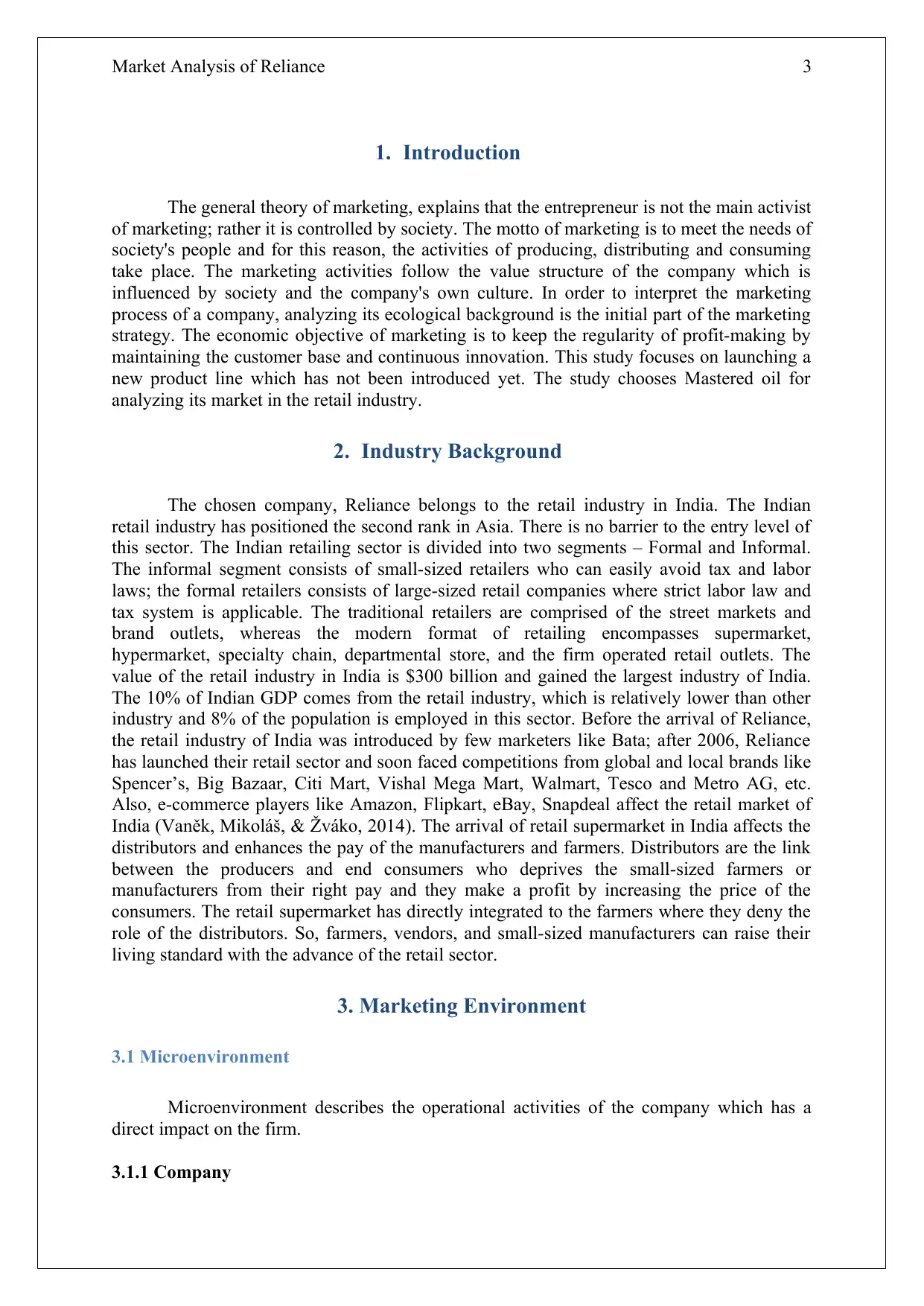
Market Analysis of Reliance 3
1. Introduction
The general theory of marketing, explains that the entrepreneur is not the main activist
of marketing; rather it is controlled by society. The motto of marketing is to meet the needs of
society's people and for this reason, the activities of producing, distributing and consuming
take place. The marketing activities follow the value structure of the company which is
influenced by society and the company's own culture. In order to interpret the marketing
process of a company, analyzing its ecological background is the initial part of the marketing
strategy. The economic objective of marketing is to keep the regularity of profit-making by
maintaining the customer base and continuous innovation. This study focuses on launching a
new product line which has not been introduced yet. The study chooses Mastered oil for
analyzing its market in the retail industry.
2. Industry Background
The chosen company, Reliance belongs to the retail industry in India. The Indian
retail industry has positioned the second rank in Asia. There is no barrier to the entry level of
this sector. The Indian retailing sector is divided into two segments – Formal and Informal.
The informal segment consists of small-sized retailers who can easily avoid tax and labor
laws; the formal retailers consists of large-sized retail companies where strict labor law and
tax system is applicable. The traditional retailers are comprised of the street markets and
brand outlets, whereas the modern format of retailing encompasses supermarket,
hypermarket, specialty chain, departmental store, and the firm operated retail outlets. The
value of the retail industry in India is $300 billion and gained the largest industry of India.
The 10% of Indian GDP comes from the retail industry, which is relatively lower than other
industry and 8% of the population is employed in this sector. Before the arrival of Reliance,
the retail industry of India was introduced by few marketers like Bata; after 2006, Reliance
has launched their retail sector and soon faced competitions from global and local brands like
Spencer’s, Big Bazaar, Citi Mart, Vishal Mega Mart, Walmart, Tesco and Metro AG, etc.
Also, e-commerce players like Amazon, Flipkart, eBay, Snapdeal affect the retail market of
India (Vaněk, Mikoláš, & Žváko, 2014). The arrival of retail supermarket in India affects the
distributors and enhances the pay of the manufacturers and farmers. Distributors are the link
between the producers and end consumers who deprives the small-sized farmers or
manufacturers from their right pay and they make a profit by increasing the price of the
consumers. The retail supermarket has directly integrated to the farmers where they deny the
role of the distributors. So, farmers, vendors, and small-sized manufacturers can raise their
living standard with the advance of the retail sector.
3. Marketing Environment
3.1 Microenvironment
Microenvironment describes the operational activities of the company which has a
direct impact on the firm.
3.1.1 Company
1. Introduction
The general theory of marketing, explains that the entrepreneur is not the main activist
of marketing; rather it is controlled by society. The motto of marketing is to meet the needs of
society's people and for this reason, the activities of producing, distributing and consuming
take place. The marketing activities follow the value structure of the company which is
influenced by society and the company's own culture. In order to interpret the marketing
process of a company, analyzing its ecological background is the initial part of the marketing
strategy. The economic objective of marketing is to keep the regularity of profit-making by
maintaining the customer base and continuous innovation. This study focuses on launching a
new product line which has not been introduced yet. The study chooses Mastered oil for
analyzing its market in the retail industry.
2. Industry Background
The chosen company, Reliance belongs to the retail industry in India. The Indian
retail industry has positioned the second rank in Asia. There is no barrier to the entry level of
this sector. The Indian retailing sector is divided into two segments – Formal and Informal.
The informal segment consists of small-sized retailers who can easily avoid tax and labor
laws; the formal retailers consists of large-sized retail companies where strict labor law and
tax system is applicable. The traditional retailers are comprised of the street markets and
brand outlets, whereas the modern format of retailing encompasses supermarket,
hypermarket, specialty chain, departmental store, and the firm operated retail outlets. The
value of the retail industry in India is $300 billion and gained the largest industry of India.
The 10% of Indian GDP comes from the retail industry, which is relatively lower than other
industry and 8% of the population is employed in this sector. Before the arrival of Reliance,
the retail industry of India was introduced by few marketers like Bata; after 2006, Reliance
has launched their retail sector and soon faced competitions from global and local brands like
Spencer’s, Big Bazaar, Citi Mart, Vishal Mega Mart, Walmart, Tesco and Metro AG, etc.
Also, e-commerce players like Amazon, Flipkart, eBay, Snapdeal affect the retail market of
India (Vaněk, Mikoláš, & Žváko, 2014). The arrival of retail supermarket in India affects the
distributors and enhances the pay of the manufacturers and farmers. Distributors are the link
between the producers and end consumers who deprives the small-sized farmers or
manufacturers from their right pay and they make a profit by increasing the price of the
consumers. The retail supermarket has directly integrated to the farmers where they deny the
role of the distributors. So, farmers, vendors, and small-sized manufacturers can raise their
living standard with the advance of the retail sector.
3. Marketing Environment
3.1 Microenvironment
Microenvironment describes the operational activities of the company which has a
direct impact on the firm.
3.1.1 Company
Paraphrase This Document
Need a fresh take? Get an instant paraphrase of this document with our AI Paraphraser
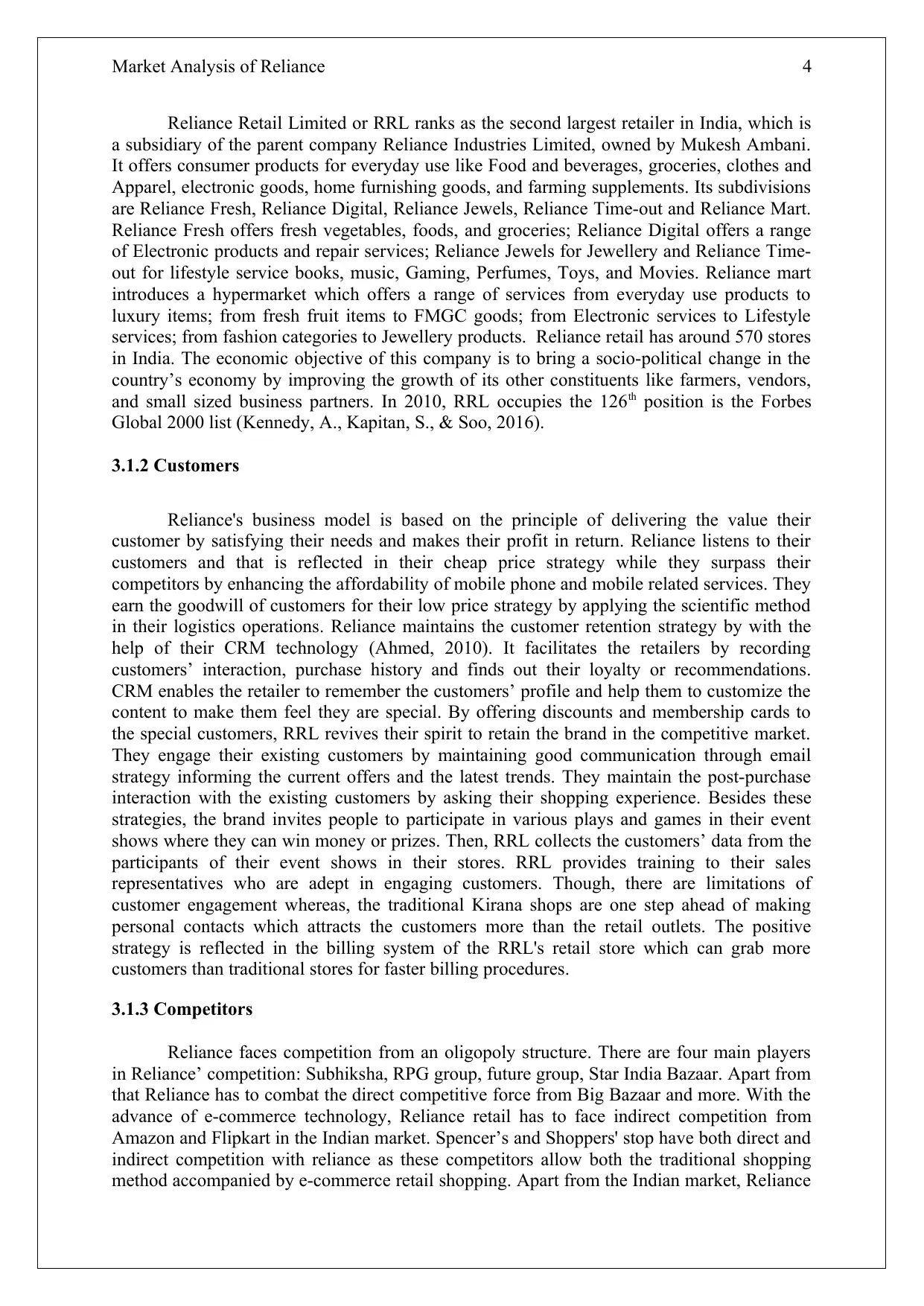
Market Analysis of Reliance 4
Reliance Retail Limited or RRL ranks as the second largest retailer in India, which is
a subsidiary of the parent company Reliance Industries Limited, owned by Mukesh Ambani.
It offers consumer products for everyday use like Food and beverages, groceries, clothes and
Apparel, electronic goods, home furnishing goods, and farming supplements. Its subdivisions
are Reliance Fresh, Reliance Digital, Reliance Jewels, Reliance Time-out and Reliance Mart.
Reliance Fresh offers fresh vegetables, foods, and groceries; Reliance Digital offers a range
of Electronic products and repair services; Reliance Jewels for Jewellery and Reliance Time-
out for lifestyle service books, music, Gaming, Perfumes, Toys, and Movies. Reliance mart
introduces a hypermarket which offers a range of services from everyday use products to
luxury items; from fresh fruit items to FMGC goods; from Electronic services to Lifestyle
services; from fashion categories to Jewellery products. Reliance retail has around 570 stores
in India. The economic objective of this company is to bring a socio-political change in the
country’s economy by improving the growth of its other constituents like farmers, vendors,
and small sized business partners. In 2010, RRL occupies the 126th position is the Forbes
Global 2000 list (Kennedy, A., Kapitan, S., & Soo, 2016).
3.1.2 Customers
Reliance's business model is based on the principle of delivering the value their
customer by satisfying their needs and makes their profit in return. Reliance listens to their
customers and that is reflected in their cheap price strategy while they surpass their
competitors by enhancing the affordability of mobile phone and mobile related services. They
earn the goodwill of customers for their low price strategy by applying the scientific method
in their logistics operations. Reliance maintains the customer retention strategy by with the
help of their CRM technology (Ahmed, 2010). It facilitates the retailers by recording
customers’ interaction, purchase history and finds out their loyalty or recommendations.
CRM enables the retailer to remember the customers’ profile and help them to customize the
content to make them feel they are special. By offering discounts and membership cards to
the special customers, RRL revives their spirit to retain the brand in the competitive market.
They engage their existing customers by maintaining good communication through email
strategy informing the current offers and the latest trends. They maintain the post-purchase
interaction with the existing customers by asking their shopping experience. Besides these
strategies, the brand invites people to participate in various plays and games in their event
shows where they can win money or prizes. Then, RRL collects the customers’ data from the
participants of their event shows in their stores. RRL provides training to their sales
representatives who are adept in engaging customers. Though, there are limitations of
customer engagement whereas, the traditional Kirana shops are one step ahead of making
personal contacts which attracts the customers more than the retail outlets. The positive
strategy is reflected in the billing system of the RRL's retail store which can grab more
customers than traditional stores for faster billing procedures.
3.1.3 Competitors
Reliance faces competition from an oligopoly structure. There are four main players
in Reliance’ competition: Subhiksha, RPG group, future group, Star India Bazaar. Apart from
that Reliance has to combat the direct competitive force from Big Bazaar and more. With the
advance of e-commerce technology, Reliance retail has to face indirect competition from
Amazon and Flipkart in the Indian market. Spencer’s and Shoppers' stop have both direct and
indirect competition with reliance as these competitors allow both the traditional shopping
method accompanied by e-commerce retail shopping. Apart from the Indian market, Reliance
Reliance Retail Limited or RRL ranks as the second largest retailer in India, which is
a subsidiary of the parent company Reliance Industries Limited, owned by Mukesh Ambani.
It offers consumer products for everyday use like Food and beverages, groceries, clothes and
Apparel, electronic goods, home furnishing goods, and farming supplements. Its subdivisions
are Reliance Fresh, Reliance Digital, Reliance Jewels, Reliance Time-out and Reliance Mart.
Reliance Fresh offers fresh vegetables, foods, and groceries; Reliance Digital offers a range
of Electronic products and repair services; Reliance Jewels for Jewellery and Reliance Time-
out for lifestyle service books, music, Gaming, Perfumes, Toys, and Movies. Reliance mart
introduces a hypermarket which offers a range of services from everyday use products to
luxury items; from fresh fruit items to FMGC goods; from Electronic services to Lifestyle
services; from fashion categories to Jewellery products. Reliance retail has around 570 stores
in India. The economic objective of this company is to bring a socio-political change in the
country’s economy by improving the growth of its other constituents like farmers, vendors,
and small sized business partners. In 2010, RRL occupies the 126th position is the Forbes
Global 2000 list (Kennedy, A., Kapitan, S., & Soo, 2016).
3.1.2 Customers
Reliance's business model is based on the principle of delivering the value their
customer by satisfying their needs and makes their profit in return. Reliance listens to their
customers and that is reflected in their cheap price strategy while they surpass their
competitors by enhancing the affordability of mobile phone and mobile related services. They
earn the goodwill of customers for their low price strategy by applying the scientific method
in their logistics operations. Reliance maintains the customer retention strategy by with the
help of their CRM technology (Ahmed, 2010). It facilitates the retailers by recording
customers’ interaction, purchase history and finds out their loyalty or recommendations.
CRM enables the retailer to remember the customers’ profile and help them to customize the
content to make them feel they are special. By offering discounts and membership cards to
the special customers, RRL revives their spirit to retain the brand in the competitive market.
They engage their existing customers by maintaining good communication through email
strategy informing the current offers and the latest trends. They maintain the post-purchase
interaction with the existing customers by asking their shopping experience. Besides these
strategies, the brand invites people to participate in various plays and games in their event
shows where they can win money or prizes. Then, RRL collects the customers’ data from the
participants of their event shows in their stores. RRL provides training to their sales
representatives who are adept in engaging customers. Though, there are limitations of
customer engagement whereas, the traditional Kirana shops are one step ahead of making
personal contacts which attracts the customers more than the retail outlets. The positive
strategy is reflected in the billing system of the RRL's retail store which can grab more
customers than traditional stores for faster billing procedures.
3.1.3 Competitors
Reliance faces competition from an oligopoly structure. There are four main players
in Reliance’ competition: Subhiksha, RPG group, future group, Star India Bazaar. Apart from
that Reliance has to combat the direct competitive force from Big Bazaar and more. With the
advance of e-commerce technology, Reliance retail has to face indirect competition from
Amazon and Flipkart in the Indian market. Spencer’s and Shoppers' stop have both direct and
indirect competition with reliance as these competitors allow both the traditional shopping
method accompanied by e-commerce retail shopping. Apart from the Indian market, Reliance
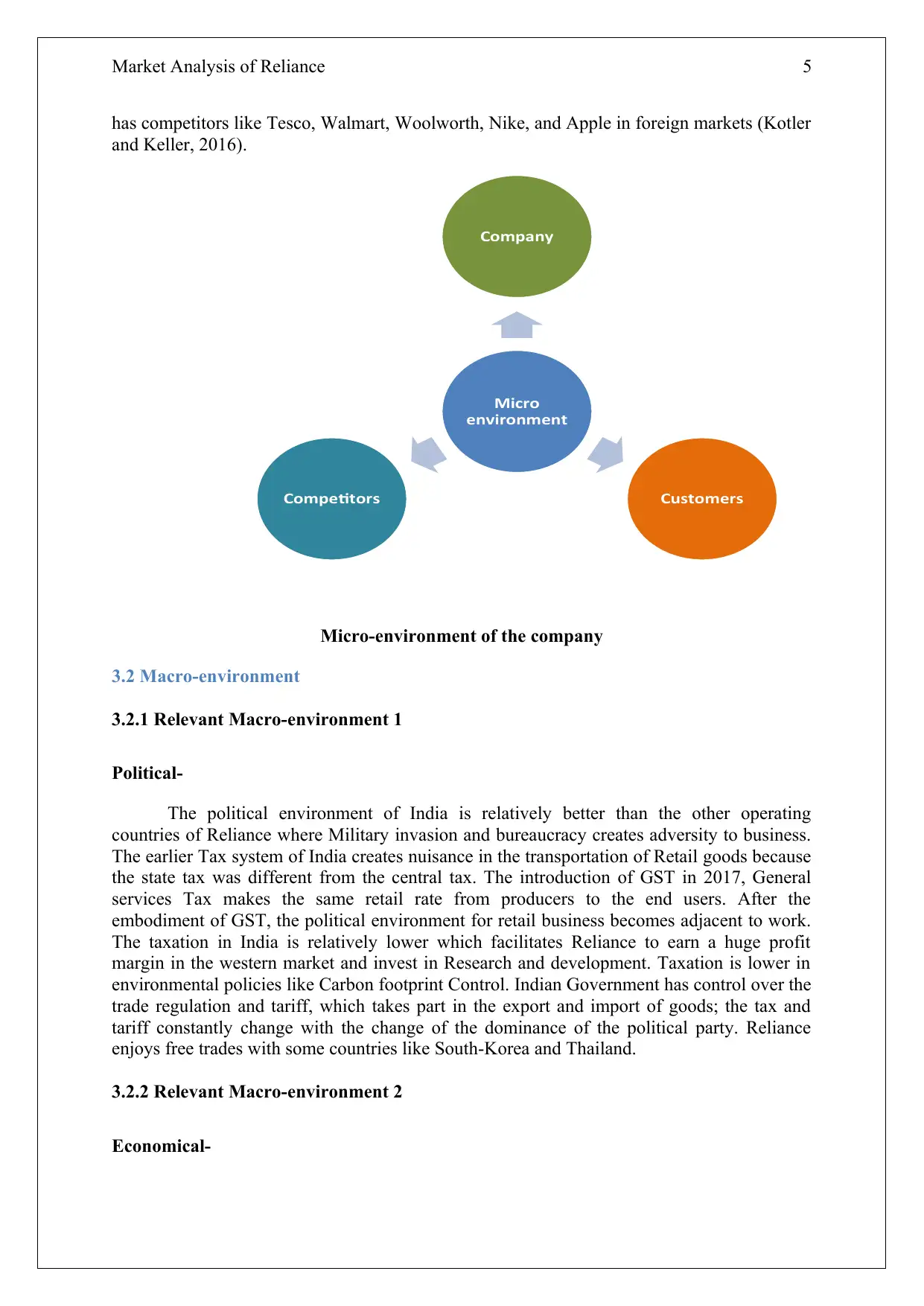
Market Analysis of Reliance 5
has competitors like Tesco, Walmart, Woolworth, Nike, and Apple in foreign markets (Kotler
and Keller, 2016).
Micro-environment of the company
3.2 Macro-environment
3.2.1 Relevant Macro-environment 1
Political-
The political environment of India is relatively better than the other operating
countries of Reliance where Military invasion and bureaucracy creates adversity to business.
The earlier Tax system of India creates nuisance in the transportation of Retail goods because
the state tax was different from the central tax. The introduction of GST in 2017, General
services Tax makes the same retail rate from producers to the end users. After the
embodiment of GST, the political environment for retail business becomes adjacent to work.
The taxation in India is relatively lower which facilitates Reliance to earn a huge profit
margin in the western market and invest in Research and development. Taxation is lower in
environmental policies like Carbon footprint Control. Indian Government has control over the
trade regulation and tariff, which takes part in the export and import of goods; the tax and
tariff constantly change with the change of the dominance of the political party. Reliance
enjoys free trades with some countries like South-Korea and Thailand.
3.2.2 Relevant Macro-environment 2
Economical-
Micro
environment
Company
CustomersCompetitors
has competitors like Tesco, Walmart, Woolworth, Nike, and Apple in foreign markets (Kotler
and Keller, 2016).
Micro-environment of the company
3.2 Macro-environment
3.2.1 Relevant Macro-environment 1
Political-
The political environment of India is relatively better than the other operating
countries of Reliance where Military invasion and bureaucracy creates adversity to business.
The earlier Tax system of India creates nuisance in the transportation of Retail goods because
the state tax was different from the central tax. The introduction of GST in 2017, General
services Tax makes the same retail rate from producers to the end users. After the
embodiment of GST, the political environment for retail business becomes adjacent to work.
The taxation in India is relatively lower which facilitates Reliance to earn a huge profit
margin in the western market and invest in Research and development. Taxation is lower in
environmental policies like Carbon footprint Control. Indian Government has control over the
trade regulation and tariff, which takes part in the export and import of goods; the tax and
tariff constantly change with the change of the dominance of the political party. Reliance
enjoys free trades with some countries like South-Korea and Thailand.
3.2.2 Relevant Macro-environment 2
Economical-
Micro
environment
Company
CustomersCompetitors
⊘ This is a preview!⊘
Do you want full access?
Subscribe today to unlock all pages.

Trusted by 1+ million students worldwide
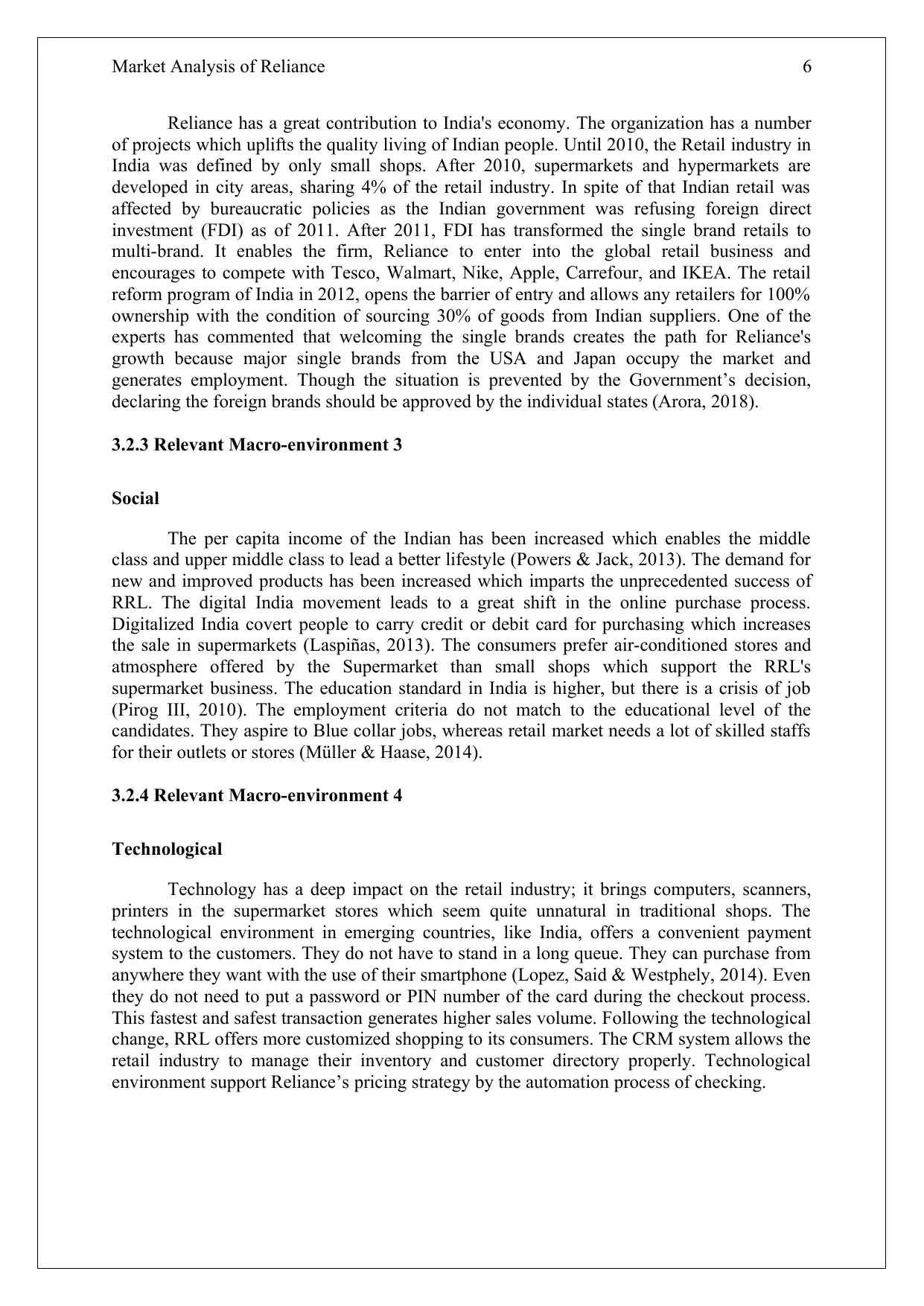
Market Analysis of Reliance 6
Reliance has a great contribution to India's economy. The organization has a number
of projects which uplifts the quality living of Indian people. Until 2010, the Retail industry in
India was defined by only small shops. After 2010, supermarkets and hypermarkets are
developed in city areas, sharing 4% of the retail industry. In spite of that Indian retail was
affected by bureaucratic policies as the Indian government was refusing foreign direct
investment (FDI) as of 2011. After 2011, FDI has transformed the single brand retails to
multi-brand. It enables the firm, Reliance to enter into the global retail business and
encourages to compete with Tesco, Walmart, Nike, Apple, Carrefour, and IKEA. The retail
reform program of India in 2012, opens the barrier of entry and allows any retailers for 100%
ownership with the condition of sourcing 30% of goods from Indian suppliers. One of the
experts has commented that welcoming the single brands creates the path for Reliance's
growth because major single brands from the USA and Japan occupy the market and
generates employment. Though the situation is prevented by the Government’s decision,
declaring the foreign brands should be approved by the individual states (Arora, 2018).
3.2.3 Relevant Macro-environment 3
Social
The per capita income of the Indian has been increased which enables the middle
class and upper middle class to lead a better lifestyle (Powers & Jack, 2013). The demand for
new and improved products has been increased which imparts the unprecedented success of
RRL. The digital India movement leads to a great shift in the online purchase process.
Digitalized India covert people to carry credit or debit card for purchasing which increases
the sale in supermarkets (Laspiñas, 2013). The consumers prefer air-conditioned stores and
atmosphere offered by the Supermarket than small shops which support the RRL's
supermarket business. The education standard in India is higher, but there is a crisis of job
(Pirog III, 2010). The employment criteria do not match to the educational level of the
candidates. They aspire to Blue collar jobs, whereas retail market needs a lot of skilled staffs
for their outlets or stores (Müller & Haase, 2014).
3.2.4 Relevant Macro-environment 4
Technological
Technology has a deep impact on the retail industry; it brings computers, scanners,
printers in the supermarket stores which seem quite unnatural in traditional shops. The
technological environment in emerging countries, like India, offers a convenient payment
system to the customers. They do not have to stand in a long queue. They can purchase from
anywhere they want with the use of their smartphone (Lopez, Said & Westphely, 2014). Even
they do not need to put a password or PIN number of the card during the checkout process.
This fastest and safest transaction generates higher sales volume. Following the technological
change, RRL offers more customized shopping to its consumers. The CRM system allows the
retail industry to manage their inventory and customer directory properly. Technological
environment support Reliance’s pricing strategy by the automation process of checking.
Reliance has a great contribution to India's economy. The organization has a number
of projects which uplifts the quality living of Indian people. Until 2010, the Retail industry in
India was defined by only small shops. After 2010, supermarkets and hypermarkets are
developed in city areas, sharing 4% of the retail industry. In spite of that Indian retail was
affected by bureaucratic policies as the Indian government was refusing foreign direct
investment (FDI) as of 2011. After 2011, FDI has transformed the single brand retails to
multi-brand. It enables the firm, Reliance to enter into the global retail business and
encourages to compete with Tesco, Walmart, Nike, Apple, Carrefour, and IKEA. The retail
reform program of India in 2012, opens the barrier of entry and allows any retailers for 100%
ownership with the condition of sourcing 30% of goods from Indian suppliers. One of the
experts has commented that welcoming the single brands creates the path for Reliance's
growth because major single brands from the USA and Japan occupy the market and
generates employment. Though the situation is prevented by the Government’s decision,
declaring the foreign brands should be approved by the individual states (Arora, 2018).
3.2.3 Relevant Macro-environment 3
Social
The per capita income of the Indian has been increased which enables the middle
class and upper middle class to lead a better lifestyle (Powers & Jack, 2013). The demand for
new and improved products has been increased which imparts the unprecedented success of
RRL. The digital India movement leads to a great shift in the online purchase process.
Digitalized India covert people to carry credit or debit card for purchasing which increases
the sale in supermarkets (Laspiñas, 2013). The consumers prefer air-conditioned stores and
atmosphere offered by the Supermarket than small shops which support the RRL's
supermarket business. The education standard in India is higher, but there is a crisis of job
(Pirog III, 2010). The employment criteria do not match to the educational level of the
candidates. They aspire to Blue collar jobs, whereas retail market needs a lot of skilled staffs
for their outlets or stores (Müller & Haase, 2014).
3.2.4 Relevant Macro-environment 4
Technological
Technology has a deep impact on the retail industry; it brings computers, scanners,
printers in the supermarket stores which seem quite unnatural in traditional shops. The
technological environment in emerging countries, like India, offers a convenient payment
system to the customers. They do not have to stand in a long queue. They can purchase from
anywhere they want with the use of their smartphone (Lopez, Said & Westphely, 2014). Even
they do not need to put a password or PIN number of the card during the checkout process.
This fastest and safest transaction generates higher sales volume. Following the technological
change, RRL offers more customized shopping to its consumers. The CRM system allows the
retail industry to manage their inventory and customer directory properly. Technological
environment support Reliance’s pricing strategy by the automation process of checking.
Paraphrase This Document
Need a fresh take? Get an instant paraphrase of this document with our AI Paraphraser
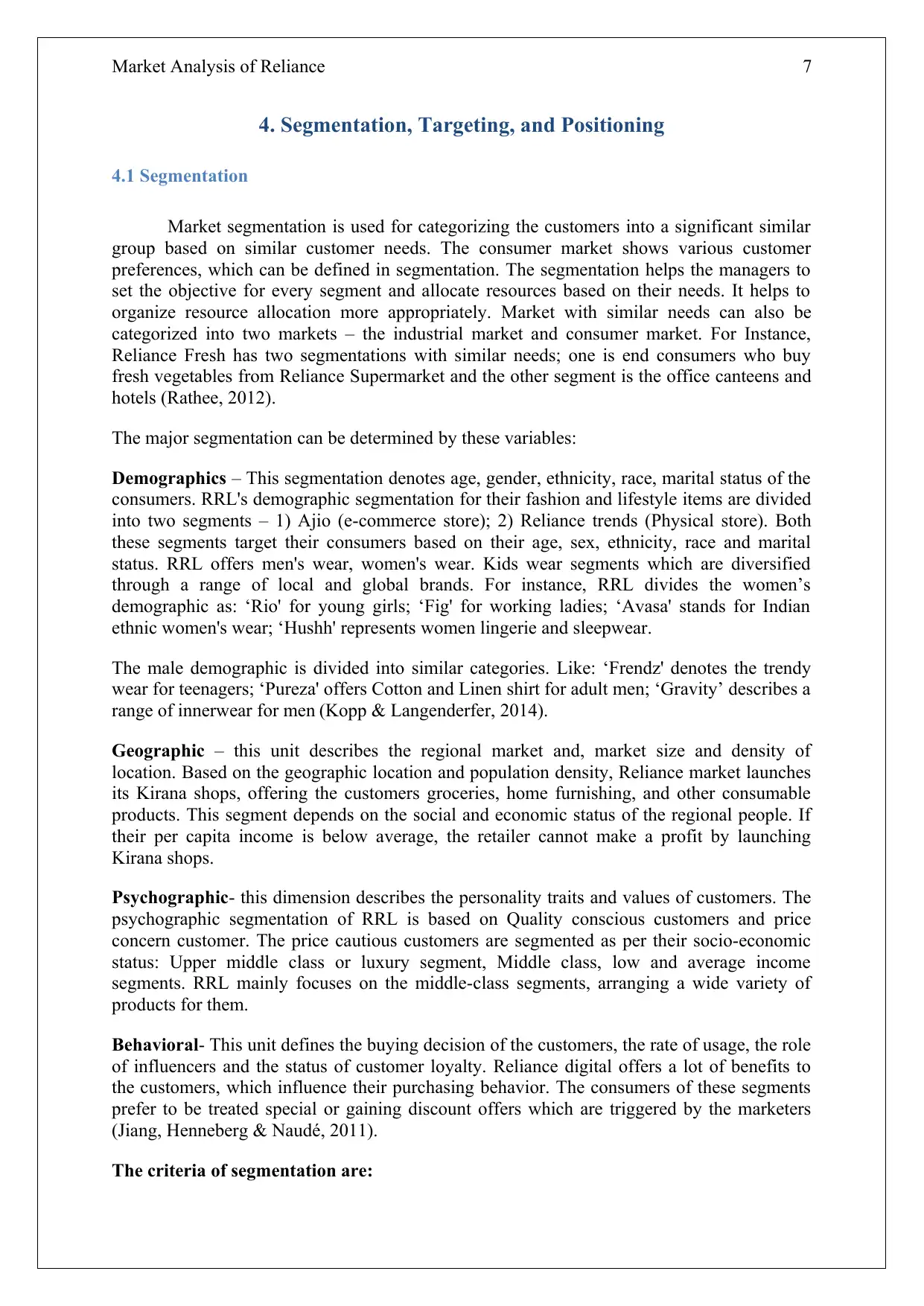
Market Analysis of Reliance 7
4. Segmentation, Targeting, and Positioning
4.1 Segmentation
Market segmentation is used for categorizing the customers into a significant similar
group based on similar customer needs. The consumer market shows various customer
preferences, which can be defined in segmentation. The segmentation helps the managers to
set the objective for every segment and allocate resources based on their needs. It helps to
organize resource allocation more appropriately. Market with similar needs can also be
categorized into two markets – the industrial market and consumer market. For Instance,
Reliance Fresh has two segmentations with similar needs; one is end consumers who buy
fresh vegetables from Reliance Supermarket and the other segment is the office canteens and
hotels (Rathee, 2012).
The major segmentation can be determined by these variables:
Demographics – This segmentation denotes age, gender, ethnicity, race, marital status of the
consumers. RRL's demographic segmentation for their fashion and lifestyle items are divided
into two segments – 1) Ajio (e-commerce store); 2) Reliance trends (Physical store). Both
these segments target their consumers based on their age, sex, ethnicity, race and marital
status. RRL offers men's wear, women's wear. Kids wear segments which are diversified
through a range of local and global brands. For instance, RRL divides the women’s
demographic as: ‘Rio' for young girls; ‘Fig' for working ladies; ‘Avasa' stands for Indian
ethnic women's wear; ‘Hushh' represents women lingerie and sleepwear.
The male demographic is divided into similar categories. Like: ‘Frendz' denotes the trendy
wear for teenagers; ‘Pureza' offers Cotton and Linen shirt for adult men; ‘Gravity’ describes a
range of innerwear for men (Kopp & Langenderfer, 2014).
Geographic – this unit describes the regional market and, market size and density of
location. Based on the geographic location and population density, Reliance market launches
its Kirana shops, offering the customers groceries, home furnishing, and other consumable
products. This segment depends on the social and economic status of the regional people. If
their per capita income is below average, the retailer cannot make a profit by launching
Kirana shops.
Psychographic- this dimension describes the personality traits and values of customers. The
psychographic segmentation of RRL is based on Quality conscious customers and price
concern customer. The price cautious customers are segmented as per their socio-economic
status: Upper middle class or luxury segment, Middle class, low and average income
segments. RRL mainly focuses on the middle-class segments, arranging a wide variety of
products for them.
Behavioral- This unit defines the buying decision of the customers, the rate of usage, the role
of influencers and the status of customer loyalty. Reliance digital offers a lot of benefits to
the customers, which influence their purchasing behavior. The consumers of these segments
prefer to be treated special or gaining discount offers which are triggered by the marketers
(Jiang, Henneberg & Naudé, 2011).
The criteria of segmentation are:
4. Segmentation, Targeting, and Positioning
4.1 Segmentation
Market segmentation is used for categorizing the customers into a significant similar
group based on similar customer needs. The consumer market shows various customer
preferences, which can be defined in segmentation. The segmentation helps the managers to
set the objective for every segment and allocate resources based on their needs. It helps to
organize resource allocation more appropriately. Market with similar needs can also be
categorized into two markets – the industrial market and consumer market. For Instance,
Reliance Fresh has two segmentations with similar needs; one is end consumers who buy
fresh vegetables from Reliance Supermarket and the other segment is the office canteens and
hotels (Rathee, 2012).
The major segmentation can be determined by these variables:
Demographics – This segmentation denotes age, gender, ethnicity, race, marital status of the
consumers. RRL's demographic segmentation for their fashion and lifestyle items are divided
into two segments – 1) Ajio (e-commerce store); 2) Reliance trends (Physical store). Both
these segments target their consumers based on their age, sex, ethnicity, race and marital
status. RRL offers men's wear, women's wear. Kids wear segments which are diversified
through a range of local and global brands. For instance, RRL divides the women’s
demographic as: ‘Rio' for young girls; ‘Fig' for working ladies; ‘Avasa' stands for Indian
ethnic women's wear; ‘Hushh' represents women lingerie and sleepwear.
The male demographic is divided into similar categories. Like: ‘Frendz' denotes the trendy
wear for teenagers; ‘Pureza' offers Cotton and Linen shirt for adult men; ‘Gravity’ describes a
range of innerwear for men (Kopp & Langenderfer, 2014).
Geographic – this unit describes the regional market and, market size and density of
location. Based on the geographic location and population density, Reliance market launches
its Kirana shops, offering the customers groceries, home furnishing, and other consumable
products. This segment depends on the social and economic status of the regional people. If
their per capita income is below average, the retailer cannot make a profit by launching
Kirana shops.
Psychographic- this dimension describes the personality traits and values of customers. The
psychographic segmentation of RRL is based on Quality conscious customers and price
concern customer. The price cautious customers are segmented as per their socio-economic
status: Upper middle class or luxury segment, Middle class, low and average income
segments. RRL mainly focuses on the middle-class segments, arranging a wide variety of
products for them.
Behavioral- This unit defines the buying decision of the customers, the rate of usage, the role
of influencers and the status of customer loyalty. Reliance digital offers a lot of benefits to
the customers, which influence their purchasing behavior. The consumers of these segments
prefer to be treated special or gaining discount offers which are triggered by the marketers
(Jiang, Henneberg & Naudé, 2011).
The criteria of segmentation are:
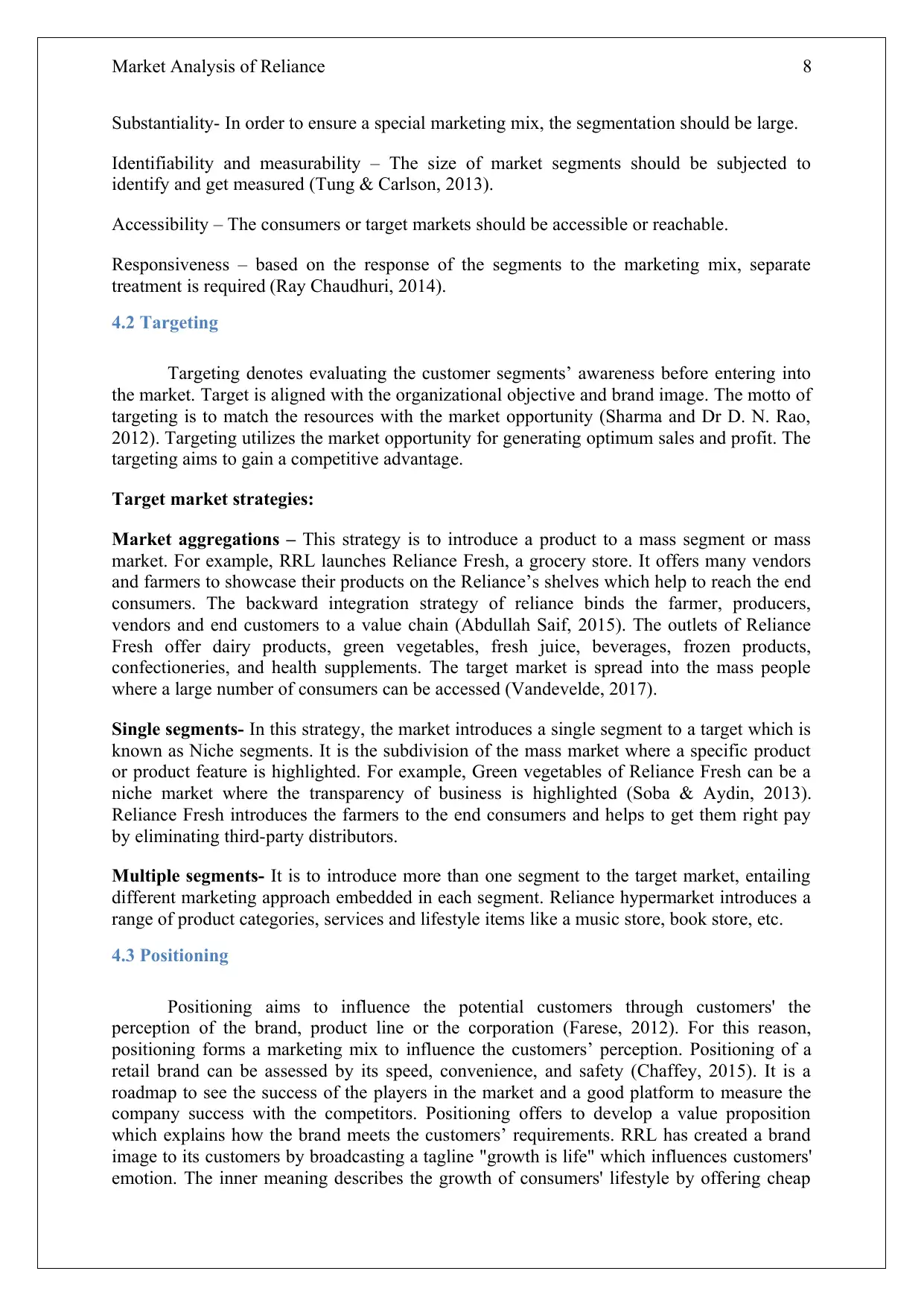
Market Analysis of Reliance 8
Substantiality- In order to ensure a special marketing mix, the segmentation should be large.
Identifiability and measurability – The size of market segments should be subjected to
identify and get measured (Tung & Carlson, 2013).
Accessibility – The consumers or target markets should be accessible or reachable.
Responsiveness – based on the response of the segments to the marketing mix, separate
treatment is required (Ray Chaudhuri, 2014).
4.2 Targeting
Targeting denotes evaluating the customer segments’ awareness before entering into
the market. Target is aligned with the organizational objective and brand image. The motto of
targeting is to match the resources with the market opportunity (Sharma and Dr D. N. Rao,
2012). Targeting utilizes the market opportunity for generating optimum sales and profit. The
targeting aims to gain a competitive advantage.
Target market strategies:
Market aggregations – This strategy is to introduce a product to a mass segment or mass
market. For example, RRL launches Reliance Fresh, a grocery store. It offers many vendors
and farmers to showcase their products on the Reliance’s shelves which help to reach the end
consumers. The backward integration strategy of reliance binds the farmer, producers,
vendors and end customers to a value chain (Abdullah Saif, 2015). The outlets of Reliance
Fresh offer dairy products, green vegetables, fresh juice, beverages, frozen products,
confectioneries, and health supplements. The target market is spread into the mass people
where a large number of consumers can be accessed (Vandevelde, 2017).
Single segments- In this strategy, the market introduces a single segment to a target which is
known as Niche segments. It is the subdivision of the mass market where a specific product
or product feature is highlighted. For example, Green vegetables of Reliance Fresh can be a
niche market where the transparency of business is highlighted (Soba & Aydin, 2013).
Reliance Fresh introduces the farmers to the end consumers and helps to get them right pay
by eliminating third-party distributors.
Multiple segments- It is to introduce more than one segment to the target market, entailing
different marketing approach embedded in each segment. Reliance hypermarket introduces a
range of product categories, services and lifestyle items like a music store, book store, etc.
4.3 Positioning
Positioning aims to influence the potential customers through customers' the
perception of the brand, product line or the corporation (Farese, 2012). For this reason,
positioning forms a marketing mix to influence the customers’ perception. Positioning of a
retail brand can be assessed by its speed, convenience, and safety (Chaffey, 2015). It is a
roadmap to see the success of the players in the market and a good platform to measure the
company success with the competitors. Positioning offers to develop a value proposition
which explains how the brand meets the customers’ requirements. RRL has created a brand
image to its customers by broadcasting a tagline "growth is life" which influences customers'
emotion. The inner meaning describes the growth of consumers' lifestyle by offering cheap
Substantiality- In order to ensure a special marketing mix, the segmentation should be large.
Identifiability and measurability – The size of market segments should be subjected to
identify and get measured (Tung & Carlson, 2013).
Accessibility – The consumers or target markets should be accessible or reachable.
Responsiveness – based on the response of the segments to the marketing mix, separate
treatment is required (Ray Chaudhuri, 2014).
4.2 Targeting
Targeting denotes evaluating the customer segments’ awareness before entering into
the market. Target is aligned with the organizational objective and brand image. The motto of
targeting is to match the resources with the market opportunity (Sharma and Dr D. N. Rao,
2012). Targeting utilizes the market opportunity for generating optimum sales and profit. The
targeting aims to gain a competitive advantage.
Target market strategies:
Market aggregations – This strategy is to introduce a product to a mass segment or mass
market. For example, RRL launches Reliance Fresh, a grocery store. It offers many vendors
and farmers to showcase their products on the Reliance’s shelves which help to reach the end
consumers. The backward integration strategy of reliance binds the farmer, producers,
vendors and end customers to a value chain (Abdullah Saif, 2015). The outlets of Reliance
Fresh offer dairy products, green vegetables, fresh juice, beverages, frozen products,
confectioneries, and health supplements. The target market is spread into the mass people
where a large number of consumers can be accessed (Vandevelde, 2017).
Single segments- In this strategy, the market introduces a single segment to a target which is
known as Niche segments. It is the subdivision of the mass market where a specific product
or product feature is highlighted. For example, Green vegetables of Reliance Fresh can be a
niche market where the transparency of business is highlighted (Soba & Aydin, 2013).
Reliance Fresh introduces the farmers to the end consumers and helps to get them right pay
by eliminating third-party distributors.
Multiple segments- It is to introduce more than one segment to the target market, entailing
different marketing approach embedded in each segment. Reliance hypermarket introduces a
range of product categories, services and lifestyle items like a music store, book store, etc.
4.3 Positioning
Positioning aims to influence the potential customers through customers' the
perception of the brand, product line or the corporation (Farese, 2012). For this reason,
positioning forms a marketing mix to influence the customers’ perception. Positioning of a
retail brand can be assessed by its speed, convenience, and safety (Chaffey, 2015). It is a
roadmap to see the success of the players in the market and a good platform to measure the
company success with the competitors. Positioning offers to develop a value proposition
which explains how the brand meets the customers’ requirements. RRL has created a brand
image to its customers by broadcasting a tagline "growth is life" which influences customers'
emotion. The inner meaning describes the growth of consumers' lifestyle by offering cheap
⊘ This is a preview!⊘
Do you want full access?
Subscribe today to unlock all pages.

Trusted by 1+ million students worldwide
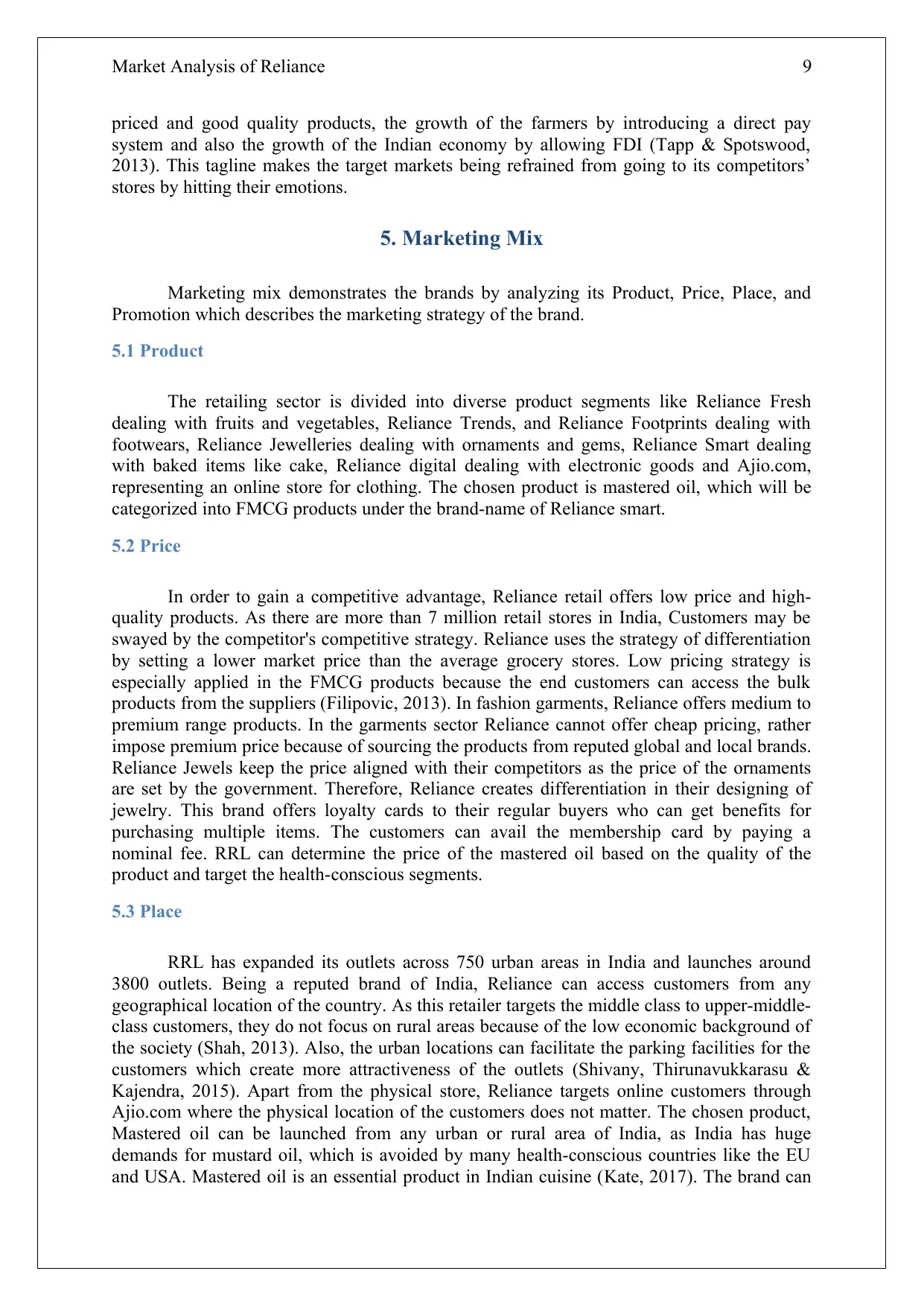
Market Analysis of Reliance 9
priced and good quality products, the growth of the farmers by introducing a direct pay
system and also the growth of the Indian economy by allowing FDI (Tapp & Spotswood,
2013). This tagline makes the target markets being refrained from going to its competitors’
stores by hitting their emotions.
5. Marketing Mix
Marketing mix demonstrates the brands by analyzing its Product, Price, Place, and
Promotion which describes the marketing strategy of the brand.
5.1 Product
The retailing sector is divided into diverse product segments like Reliance Fresh
dealing with fruits and vegetables, Reliance Trends, and Reliance Footprints dealing with
footwears, Reliance Jewelleries dealing with ornaments and gems, Reliance Smart dealing
with baked items like cake, Reliance digital dealing with electronic goods and Ajio.com,
representing an online store for clothing. The chosen product is mastered oil, which will be
categorized into FMCG products under the brand-name of Reliance smart.
5.2 Price
In order to gain a competitive advantage, Reliance retail offers low price and high-
quality products. As there are more than 7 million retail stores in India, Customers may be
swayed by the competitor's competitive strategy. Reliance uses the strategy of differentiation
by setting a lower market price than the average grocery stores. Low pricing strategy is
especially applied in the FMCG products because the end customers can access the bulk
products from the suppliers (Filipovic, 2013). In fashion garments, Reliance offers medium to
premium range products. In the garments sector Reliance cannot offer cheap pricing, rather
impose premium price because of sourcing the products from reputed global and local brands.
Reliance Jewels keep the price aligned with their competitors as the price of the ornaments
are set by the government. Therefore, Reliance creates differentiation in their designing of
jewelry. This brand offers loyalty cards to their regular buyers who can get benefits for
purchasing multiple items. The customers can avail the membership card by paying a
nominal fee. RRL can determine the price of the mastered oil based on the quality of the
product and target the health-conscious segments.
5.3 Place
RRL has expanded its outlets across 750 urban areas in India and launches around
3800 outlets. Being a reputed brand of India, Reliance can access customers from any
geographical location of the country. As this retailer targets the middle class to upper-middle-
class customers, they do not focus on rural areas because of the low economic background of
the society (Shah, 2013). Also, the urban locations can facilitate the parking facilities for the
customers which create more attractiveness of the outlets (Shivany, Thirunavukkarasu &
Kajendra, 2015). Apart from the physical store, Reliance targets online customers through
Ajio.com where the physical location of the customers does not matter. The chosen product,
Mastered oil can be launched from any urban or rural area of India, as India has huge
demands for mustard oil, which is avoided by many health-conscious countries like the EU
and USA. Mastered oil is an essential product in Indian cuisine (Kate, 2017). The brand can
priced and good quality products, the growth of the farmers by introducing a direct pay
system and also the growth of the Indian economy by allowing FDI (Tapp & Spotswood,
2013). This tagline makes the target markets being refrained from going to its competitors’
stores by hitting their emotions.
5. Marketing Mix
Marketing mix demonstrates the brands by analyzing its Product, Price, Place, and
Promotion which describes the marketing strategy of the brand.
5.1 Product
The retailing sector is divided into diverse product segments like Reliance Fresh
dealing with fruits and vegetables, Reliance Trends, and Reliance Footprints dealing with
footwears, Reliance Jewelleries dealing with ornaments and gems, Reliance Smart dealing
with baked items like cake, Reliance digital dealing with electronic goods and Ajio.com,
representing an online store for clothing. The chosen product is mastered oil, which will be
categorized into FMCG products under the brand-name of Reliance smart.
5.2 Price
In order to gain a competitive advantage, Reliance retail offers low price and high-
quality products. As there are more than 7 million retail stores in India, Customers may be
swayed by the competitor's competitive strategy. Reliance uses the strategy of differentiation
by setting a lower market price than the average grocery stores. Low pricing strategy is
especially applied in the FMCG products because the end customers can access the bulk
products from the suppliers (Filipovic, 2013). In fashion garments, Reliance offers medium to
premium range products. In the garments sector Reliance cannot offer cheap pricing, rather
impose premium price because of sourcing the products from reputed global and local brands.
Reliance Jewels keep the price aligned with their competitors as the price of the ornaments
are set by the government. Therefore, Reliance creates differentiation in their designing of
jewelry. This brand offers loyalty cards to their regular buyers who can get benefits for
purchasing multiple items. The customers can avail the membership card by paying a
nominal fee. RRL can determine the price of the mastered oil based on the quality of the
product and target the health-conscious segments.
5.3 Place
RRL has expanded its outlets across 750 urban areas in India and launches around
3800 outlets. Being a reputed brand of India, Reliance can access customers from any
geographical location of the country. As this retailer targets the middle class to upper-middle-
class customers, they do not focus on rural areas because of the low economic background of
the society (Shah, 2013). Also, the urban locations can facilitate the parking facilities for the
customers which create more attractiveness of the outlets (Shivany, Thirunavukkarasu &
Kajendra, 2015). Apart from the physical store, Reliance targets online customers through
Ajio.com where the physical location of the customers does not matter. The chosen product,
Mastered oil can be launched from any urban or rural area of India, as India has huge
demands for mustard oil, which is avoided by many health-conscious countries like the EU
and USA. Mastered oil is an essential product in Indian cuisine (Kate, 2017). The brand can
Paraphrase This Document
Need a fresh take? Get an instant paraphrase of this document with our AI Paraphraser
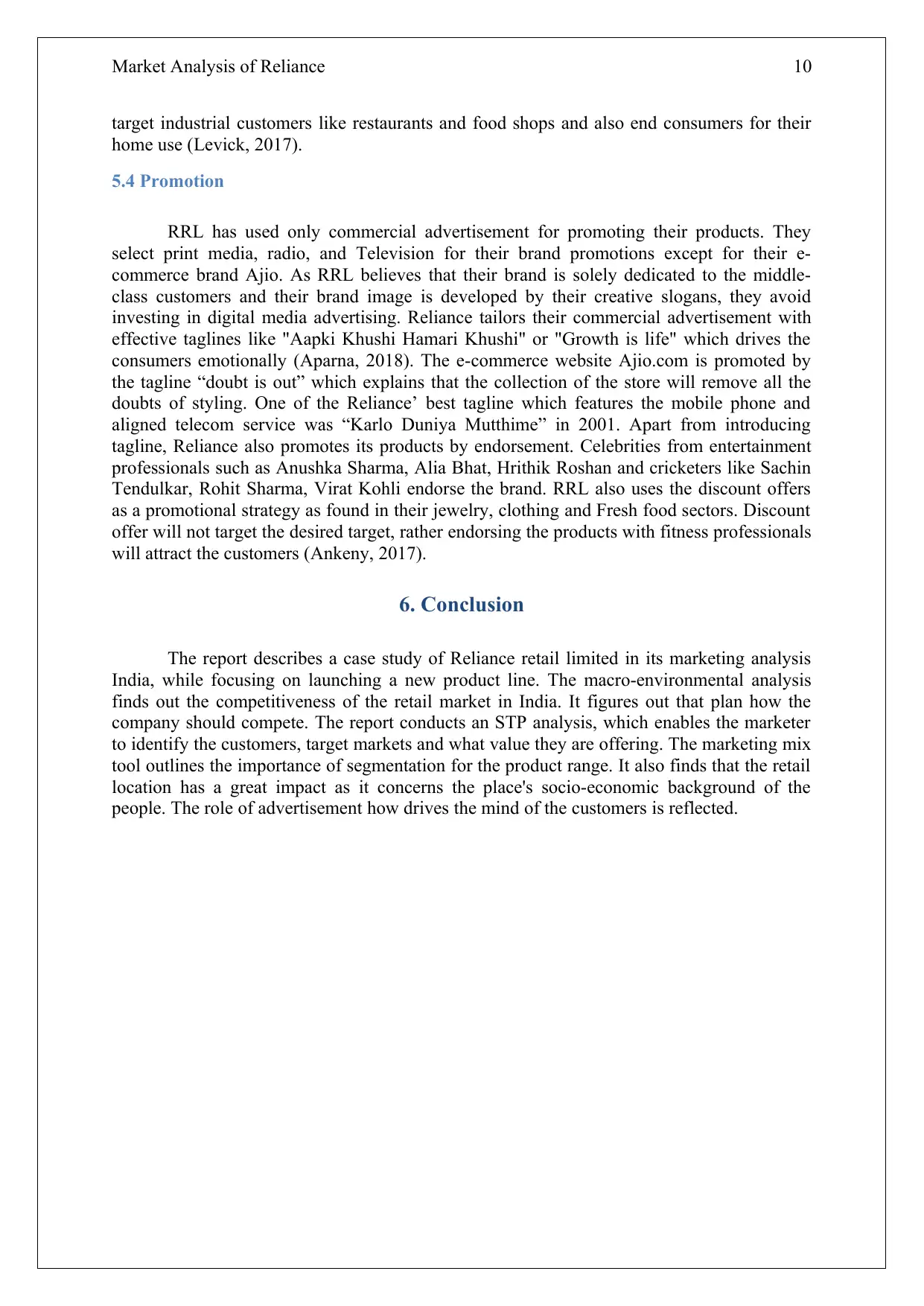
Market Analysis of Reliance 10
target industrial customers like restaurants and food shops and also end consumers for their
home use (Levick, 2017).
5.4 Promotion
RRL has used only commercial advertisement for promoting their products. They
select print media, radio, and Television for their brand promotions except for their e-
commerce brand Ajio. As RRL believes that their brand is solely dedicated to the middle-
class customers and their brand image is developed by their creative slogans, they avoid
investing in digital media advertising. Reliance tailors their commercial advertisement with
effective taglines like "Aapki Khushi Hamari Khushi" or "Growth is life" which drives the
consumers emotionally (Aparna, 2018). The e-commerce website Ajio.com is promoted by
the tagline “doubt is out” which explains that the collection of the store will remove all the
doubts of styling. One of the Reliance’ best tagline which features the mobile phone and
aligned telecom service was “Karlo Duniya Mutthime” in 2001. Apart from introducing
tagline, Reliance also promotes its products by endorsement. Celebrities from entertainment
professionals such as Anushka Sharma, Alia Bhat, Hrithik Roshan and cricketers like Sachin
Tendulkar, Rohit Sharma, Virat Kohli endorse the brand. RRL also uses the discount offers
as a promotional strategy as found in their jewelry, clothing and Fresh food sectors. Discount
offer will not target the desired target, rather endorsing the products with fitness professionals
will attract the customers (Ankeny, 2017).
6. Conclusion
The report describes a case study of Reliance retail limited in its marketing analysis
India, while focusing on launching a new product line. The macro-environmental analysis
finds out the competitiveness of the retail market in India. It figures out that plan how the
company should compete. The report conducts an STP analysis, which enables the marketer
to identify the customers, target markets and what value they are offering. The marketing mix
tool outlines the importance of segmentation for the product range. It also finds that the retail
location has a great impact as it concerns the place's socio-economic background of the
people. The role of advertisement how drives the mind of the customers is reflected.
target industrial customers like restaurants and food shops and also end consumers for their
home use (Levick, 2017).
5.4 Promotion
RRL has used only commercial advertisement for promoting their products. They
select print media, radio, and Television for their brand promotions except for their e-
commerce brand Ajio. As RRL believes that their brand is solely dedicated to the middle-
class customers and their brand image is developed by their creative slogans, they avoid
investing in digital media advertising. Reliance tailors their commercial advertisement with
effective taglines like "Aapki Khushi Hamari Khushi" or "Growth is life" which drives the
consumers emotionally (Aparna, 2018). The e-commerce website Ajio.com is promoted by
the tagline “doubt is out” which explains that the collection of the store will remove all the
doubts of styling. One of the Reliance’ best tagline which features the mobile phone and
aligned telecom service was “Karlo Duniya Mutthime” in 2001. Apart from introducing
tagline, Reliance also promotes its products by endorsement. Celebrities from entertainment
professionals such as Anushka Sharma, Alia Bhat, Hrithik Roshan and cricketers like Sachin
Tendulkar, Rohit Sharma, Virat Kohli endorse the brand. RRL also uses the discount offers
as a promotional strategy as found in their jewelry, clothing and Fresh food sectors. Discount
offer will not target the desired target, rather endorsing the products with fitness professionals
will attract the customers (Ankeny, 2017).
6. Conclusion
The report describes a case study of Reliance retail limited in its marketing analysis
India, while focusing on launching a new product line. The macro-environmental analysis
finds out the competitiveness of the retail market in India. It figures out that plan how the
company should compete. The report conducts an STP analysis, which enables the marketer
to identify the customers, target markets and what value they are offering. The marketing mix
tool outlines the importance of segmentation for the product range. It also finds that the retail
location has a great impact as it concerns the place's socio-economic background of the
people. The role of advertisement how drives the mind of the customers is reflected.
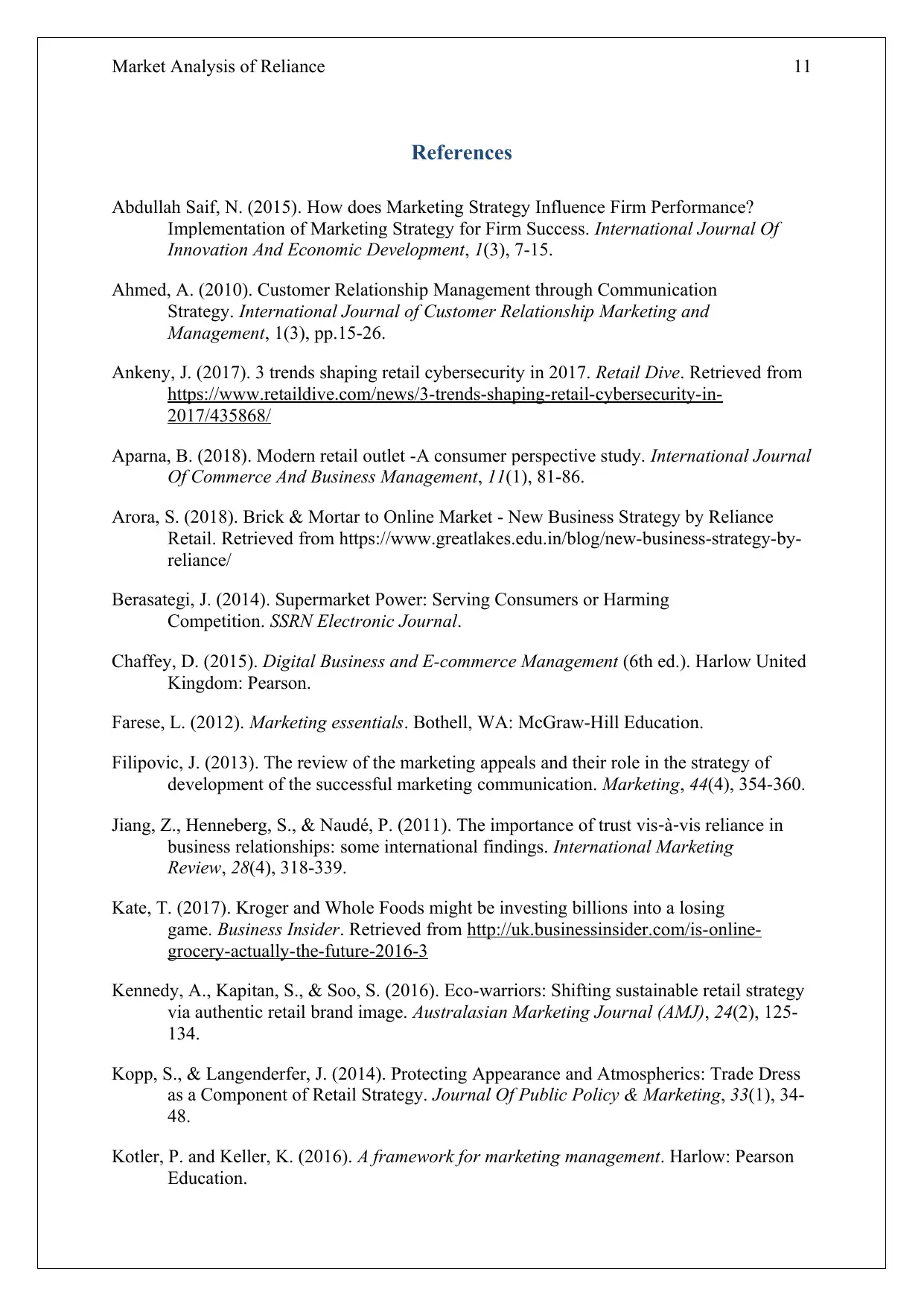
Market Analysis of Reliance 11
References
Abdullah Saif, N. (2015). How does Marketing Strategy Influence Firm Performance?
Implementation of Marketing Strategy for Firm Success. International Journal Of
Innovation And Economic Development, 1(3), 7-15.
Ahmed, A. (2010). Customer Relationship Management through Communication
Strategy. International Journal of Customer Relationship Marketing and
Management, 1(3), pp.15-26.
Ankeny, J. (2017). 3 trends shaping retail cybersecurity in 2017. Retail Dive. Retrieved from
https://www.retaildive.com/news/3-trends-shaping-retail-cybersecurity-in-
2017/435868/
Aparna, B. (2018). Modern retail outlet -A consumer perspective study. International Journal
Of Commerce And Business Management, 11(1), 81-86.
Arora, S. (2018). Brick & Mortar to Online Market - New Business Strategy by Reliance
Retail. Retrieved from https://www.greatlakes.edu.in/blog/new-business-strategy-by-
reliance/
Berasategi, J. (2014). Supermarket Power: Serving Consumers or Harming
Competition. SSRN Electronic Journal.
Chaffey, D. (2015). Digital Business and E-commerce Management (6th ed.). Harlow United
Kingdom: Pearson.
Farese, L. (2012). Marketing essentials. Bothell, WA: McGraw-Hill Education.
Filipovic, J. (2013). The review of the marketing appeals and their role in the strategy of
development of the successful marketing communication. Marketing, 44(4), 354-360.
Jiang, Z., Henneberg, S., & Naudé, P. (2011). The importance of trust vis‐à‐vis reliance in
business relationships: some international findings. International Marketing
Review, 28(4), 318-339.
Kate, T. (2017). Kroger and Whole Foods might be investing billions into a losing
game. Business Insider. Retrieved from http://uk.businessinsider.com/is-online-
grocery-actually-the-future-2016-3
Kennedy, A., Kapitan, S., & Soo, S. (2016). Eco-warriors: Shifting sustainable retail strategy
via authentic retail brand image. Australasian Marketing Journal (AMJ), 24(2), 125-
134.
Kopp, S., & Langenderfer, J. (2014). Protecting Appearance and Atmospherics: Trade Dress
as a Component of Retail Strategy. Journal Of Public Policy & Marketing, 33(1), 34-
48.
Kotler, P. and Keller, K. (2016). A framework for marketing management. Harlow: Pearson
Education.
References
Abdullah Saif, N. (2015). How does Marketing Strategy Influence Firm Performance?
Implementation of Marketing Strategy for Firm Success. International Journal Of
Innovation And Economic Development, 1(3), 7-15.
Ahmed, A. (2010). Customer Relationship Management through Communication
Strategy. International Journal of Customer Relationship Marketing and
Management, 1(3), pp.15-26.
Ankeny, J. (2017). 3 trends shaping retail cybersecurity in 2017. Retail Dive. Retrieved from
https://www.retaildive.com/news/3-trends-shaping-retail-cybersecurity-in-
2017/435868/
Aparna, B. (2018). Modern retail outlet -A consumer perspective study. International Journal
Of Commerce And Business Management, 11(1), 81-86.
Arora, S. (2018). Brick & Mortar to Online Market - New Business Strategy by Reliance
Retail. Retrieved from https://www.greatlakes.edu.in/blog/new-business-strategy-by-
reliance/
Berasategi, J. (2014). Supermarket Power: Serving Consumers or Harming
Competition. SSRN Electronic Journal.
Chaffey, D. (2015). Digital Business and E-commerce Management (6th ed.). Harlow United
Kingdom: Pearson.
Farese, L. (2012). Marketing essentials. Bothell, WA: McGraw-Hill Education.
Filipovic, J. (2013). The review of the marketing appeals and their role in the strategy of
development of the successful marketing communication. Marketing, 44(4), 354-360.
Jiang, Z., Henneberg, S., & Naudé, P. (2011). The importance of trust vis‐à‐vis reliance in
business relationships: some international findings. International Marketing
Review, 28(4), 318-339.
Kate, T. (2017). Kroger and Whole Foods might be investing billions into a losing
game. Business Insider. Retrieved from http://uk.businessinsider.com/is-online-
grocery-actually-the-future-2016-3
Kennedy, A., Kapitan, S., & Soo, S. (2016). Eco-warriors: Shifting sustainable retail strategy
via authentic retail brand image. Australasian Marketing Journal (AMJ), 24(2), 125-
134.
Kopp, S., & Langenderfer, J. (2014). Protecting Appearance and Atmospherics: Trade Dress
as a Component of Retail Strategy. Journal Of Public Policy & Marketing, 33(1), 34-
48.
Kotler, P. and Keller, K. (2016). A framework for marketing management. Harlow: Pearson
Education.
⊘ This is a preview!⊘
Do you want full access?
Subscribe today to unlock all pages.

Trusted by 1+ million students worldwide
1 out of 14
Related Documents
Your All-in-One AI-Powered Toolkit for Academic Success.
+13062052269
info@desklib.com
Available 24*7 on WhatsApp / Email
![[object Object]](/_next/static/media/star-bottom.7253800d.svg)
Unlock your academic potential
Copyright © 2020–2025 A2Z Services. All Rights Reserved. Developed and managed by ZUCOL.





